Measurement of the muon neutrino charged-current cross sections on water, hydrocarbon and iron, and their ratios, with the T2K on-axis detectors
σ^{H2O}_{CC}=(0.840±0.010(stat.)+0.10−0.08(syst.))×10−38cm2/nucleon, σ^{CH}_{CC}=(0.817±0.007(stat.)+0.11−0.08(syst.))×10−38cm2/nucleon, and σ^{Fe}_CC=(0.859±0.003(stat.)+0.12−0.10(syst.))×10−38cm2/nucleon,
respectively, for a restricted phase space of induced muons: θμ<45∘ and pμ>0.4 GeV/c in the laboratory frame. The measured cross section ratios are σ^{H2O}_{CC}/σ^{CH}_CC=1.028±0.016(stat.)±0.053(syst.), σ^{Fe}_{CC}/σ^{H2O}_{CC}=1.023±0.012(stat.)±0.058(syst.), and σ^{Fe}_{CC}/σ^{CH}_{CC}=1.049±0.010(stat.)±0.043(syst.). These results, with an unprecedented precision for the measurements of neutrino cross sections on water in the studied energy region, show good agreement with the current neutrino interaction models used in the T2K oscillation analyses.
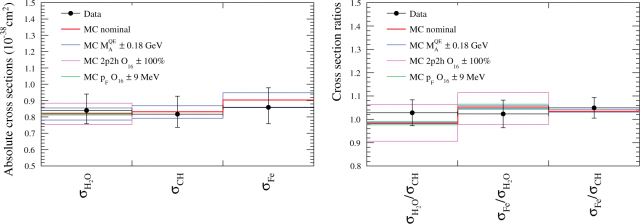
Search for neutral-current induced single photon production at the ND280 near detector in T2K
DOI: https://dx.doi.org/10.1088/1361-6471/ab227d
ArXiv: https://arxiv.org/abs/1902.03848
Physics World: https://physicsworld.com/a/t2k-searches-for-single-gamma-rays-from-neutrino-interactions
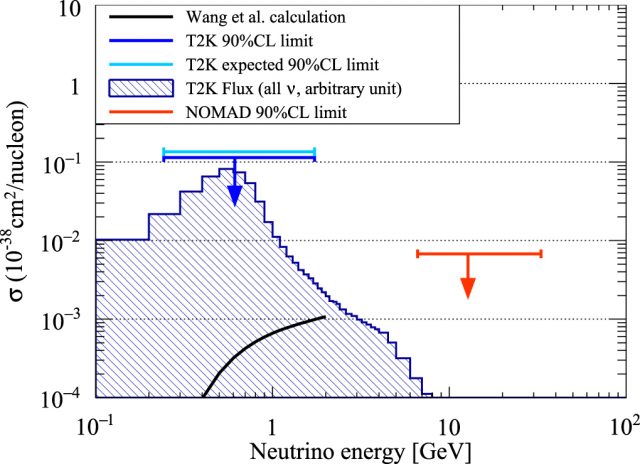
Measurement of muon- antineutrino and neutrino charged-current inclusive cross sections and their ratio with the T2K off-axis near detector
We report a measurement of cross section σ(νμ+nucleus→μ-+X) and the first measurements of the cross section σ(ν¯μ+nucleus→μ++X) and their ratio R(σ(ν¯)σ(ν)) at (anti) neutrino energies below 1.5 GeV. We determine the single momentum bin cross section measurements, averaged over the T2K ν¯/ν-flux, for the detector target material (mainly carbon, oxygen, hydrogen and copper) with phase space restricted laboratory frame kinematics of θμ<32° and pμ>500 MeV/c. The results are σ(ν¯)=(0.900±0.029(stat)±0.088(syst))×10-39 and σ(ν)=(2.41±0.022(stat)±0.231(syst))×10-39 in units of cm2/nucleon and R(σ(ν¯)σ(ν))=0.373±0.012(stat)±0.015(syst).
Measurement of inclusive double-differential νμ charged-current cross section with improved acceptance
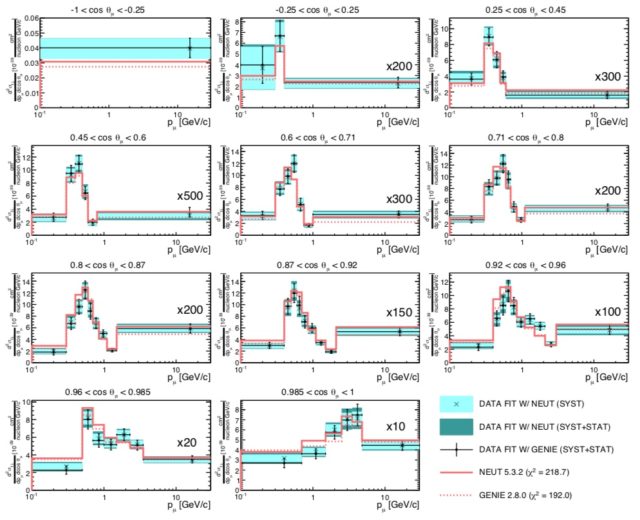
Characterisation of nuclear effects in neutrino scattering with a measurement of final-state kinematics (2018)
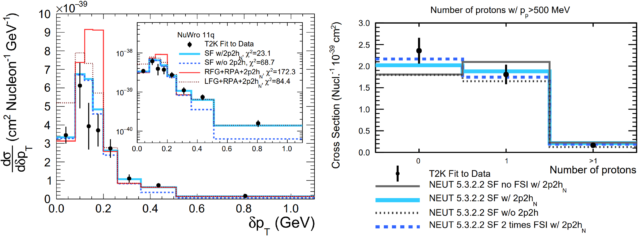
First measurement of the νμ charged-current cross section without pions in the final state on a water target
arXiv:1708.06771 [hep-ex], Phys.Rev. D97 (2018) no.1, 012001. The data release for this paper is here.

Measurement of Coherent π+ Production in Low Energy Neutrino-Carbon Scattering
We report the first measurement of the flux-averaged cross section for charged current coherent π+ production on carbon for neutrino energies less than 1.5 GeV, and with a restriction on the final state phase space volume in the T2K near detector, ND280. Comparisons are made with predictions from the Rein-Sehgal coherent production model and the model by Alvarez-Ruso et al., the latter representing the first implementation of an instance of the new class of microscopic coherent models in a neutrino interaction Monte Carlo event generator. We observe a clear event excess above background, disagreeing with the null results reported by K2K and SciBooNE in a similar neutrino energy region. The measured flux-averaged cross sections are below those predicted by both the Rein-Sehgal and Alvarez-Ruso et al. models.
First Measurement of the Muon Neutrino Charged Current Single Pion Production Cross Section on Water with the T2K Near Detector
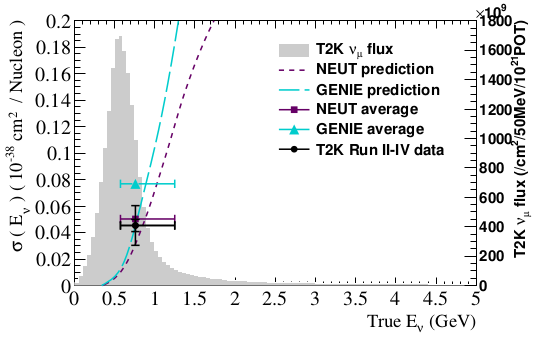
The T2K off-axis near detector, ND280, is used to make the first differential cross section measurements of muon neutrino charged current single positive pion production on a water target at energies ∼0.8~GeV. The differential measurements are presented as a function of muon and pion kinematics, in the restricted phase-space defined by pπ+>200MeV/c, pμ− >200MeV/c, cosθπ+ >0.3 and cosθμ− >0.3. The total flux integrated νμ charged current single positive pion production cross section on water in the restricted phase-space is measured to be ⟨σ⟩ϕ=4.25±0.48 (stat)±1.56 (syst)×10−40 cm2/nucleon. The total cross section is consistent with the NEUT prediction (5.03×10−40 cm2/nucleon) and 2σ lower than the GENIE prediction (7.68×10−40 cm2/nucleon). The differential cross sections are in good agreement with the NEUT generator. The GENIE simulation reproduces well the shapes of the distributions, but over-estimates the overall cross section normalization.
Measurement of double-differential muon neutrino charged-current interactions on C8H8 without pions in the final state using the T2K off-axis beam
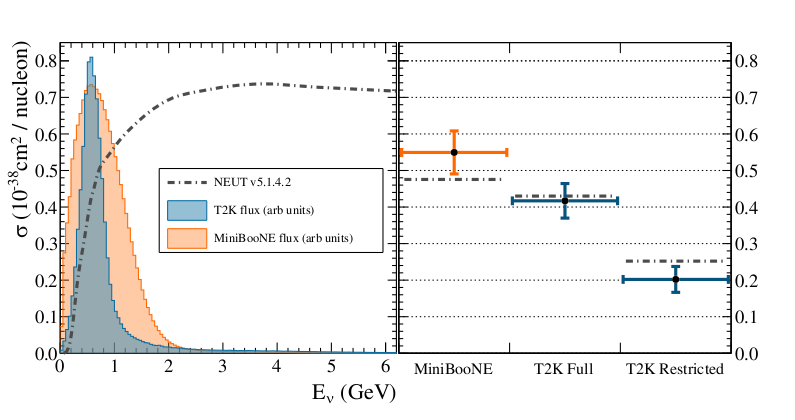
We report the measurement of muon neutrino charged-current interactions on carbon without pions in the final state at the T2K beam energy using 5.734×1020 protons on target. For the first time the measurement is reported as a flux-integrated, double-differential cross-section in muon kinematic variables (cosθμ, pμ), without correcting for events where a pion is produced and then absorbed by final state interactions. Two analyses are performed with different selections, background evaluations and cross-section extraction methods to demonstrate the robustness of the results against biases due to model-dependent assumptions. The measurements compare favorably with recent models which include nucleon-nucleon correlations but, given the present precision, the measurement does not solve the degeneracy between different models. The data also agree with Monte Carlo simulations which use effective parameters that are tuned to external data to describe the nuclear effects. The total cross-section in the full phase space is σ=(0.417±0.047(syst)±0.005(stat))×10−38cm2 nucleon−1 and the cross-section integrated in the region of phase space with largest efficiency and best signal-over-background ratio (cosθμ>0.6 and pμ>200 MeV) is σ=(0.202±0.0359(syst)±0.0026(stat))×10−38cm2 nucleon−1.
Measurement of the muon neutrino inclusive charged-current cross section in the energy range of 1-3 GeV with the T2K INGRID detector
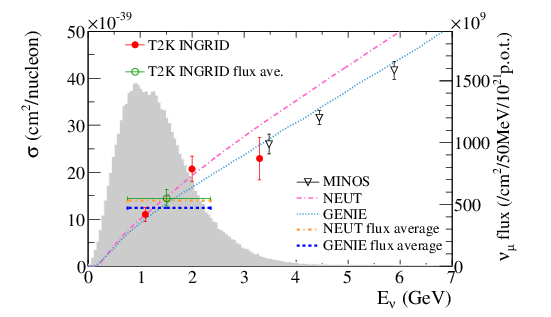
We report a measurement of the νμ-nucleus inclusive charged current cross section (=σcc) on iron using data from exposed to the J-PARC neutrino beam. The detector consists of 14 modules in total, which are spread over a range of off-axis angles from 0° to 1.1°. The variation in the neutrino energy spectrum as a function of the off-axis angle, combined with event topology information, is used to calculate this cross section as a function of neutrino energy. The cross section is measured to be σcc(1.1 GeV)=1.10±0.15 (10−38cm2/nucleon), σcc(2.0 GeV)=2.07±0.27 (10−38cm2/nucleon), and σcc(3.3 GeV)=2.29±0.45 (10−38cm2/nucleon), at energies of 1.1, 2.0, and 3.3 GeV, respectively. These results are consistent with the cross section calculated by the neutrino interaction generators currently used by T2K. More importantly, the method described here opens up a new way to determine the energy dependence of neutrino-nucleus cross sections.


